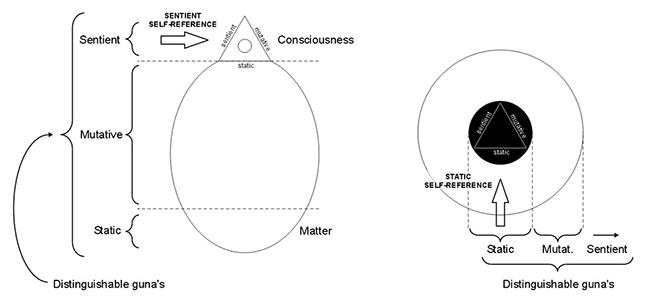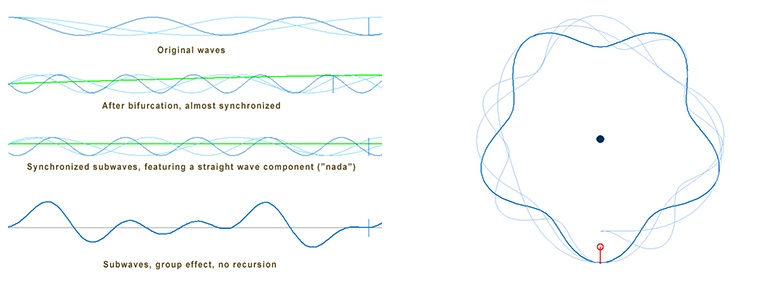Building an atom from microvita
| • How can we combine a pinnacle of physics with a pinnacle of philosophy? • What is the most suitable model or visualization of the "microvitic atom? • What is the role of elementary particles in the microvitic atom? |
The unitary bifurcation of sub-waves shows how the Action Principle of physics is applied in a creation paradigm analogous to that of axiomatic guna logic.
In physics, the Action Principle is widely used as a powerful mathematical tool for describing systems which can otherwise be dealt with only with great difficulty. The Action Principle is however barely appreciated as a fundamental principle (invariant) in nature, such as energy. The more precise application is the Principle of Least Action, a rather abstract form of equilibrium in physical systems. In quantum physics, the smallest instance of action is the Planck constant, having a wide range of applications.

Principle of Least Action (red trajectory)
In philosophy, the guna's and their synchronized state (trigunatmika) have no reality in the absolute sense, but are superior to their effect and are implied by them. The guna's at this point are still indistinguishable. Only after the creative force breaks out, each of the individual guna's can be discerned, that is, through their resp. effects. A somewhat deeper analysis reveils that the creative process is self-referential, in that the original guna trikona as a whole represents the sentient force, and so on. This is evidence of Swabhava, the "characteristic bearing of consciousness".

Sentient- vs. static self-reference ("svabhava") in spiritual philosophy ("Cycle of Creation through the nucleus")
resp. physics ("atom" = "Cycle of Creation around the nucleus")
On a very similar footing, if sub-waves converge, bifurcate and synchronize (in a mathematically exact fashion), the original waves have no distinct function yet. The sub-waves that subsequently become associated with (1) the phase- or matter-wave resp. its charge, together are analogous to the mutative principle. The final, dimensional form is a-causal, and this is what distinguishes and separates the static and sentient principles, that is, (2) the nucleus and (3) the infinite, dimensional space around, and their associated waves.

Sub-waves, bifurcating and synchronized in preliminary stages, resp. associated with the phase- or matter-wave in an atom in the
intermediary
stage,
and with the nucleus in the final stage.
Only in the latter case, the "guna-like" qualities of the sub-waves become detectible.
A more precise representation can make use of various functional models, such as the The Broglie model, spinors, and a spherical (bifurcative) potential well.

Functional models in sub-wave creation
The De Broglie model is relatively simple, it illustrates the matter wave, but is not suitable to explain the forming of the nucleus. The spinor models describe the matter wave, that is, the spinning electron, as well as the nucleus (spinning quarks) itself in greater detail. The spherical potential well finally, demonstrates the dimensionalisation. All models are useful, whereas the latter is arguably the most inclusive, and also most abstract approach.
Conceptually, the sub-wave / microvita atom lies in between the De Broglie and the Schrödinger models: it is not as purely physical as the former, and not as entirely abstract as the latter.
Clearly, sub-wave / microvita creation offers a holistic and synergetic approach to the architecture of the atom, with somewhat less emphasis on sub-atomic particles as its physics counterpart. The function of microvita in all of this is that they are thought to constitute the (Principle of) Least Action, that is on this level, the quantum of action, which is the Planck constant, in a self-referential, and therefore synergetic (pro-life, pro-mind) context.